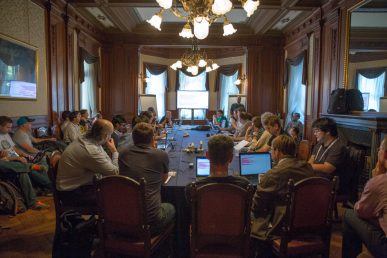Join the people building and operating open infrastructure at the OpenStack Summit Vancouver in May. The Summit schedule features over 300 sessions organized by use cases including: artificial intelligence and machine learning, high performance computing, edge computing, network functions virtualization, container infrastructure and public, private and multi-cloud strategies.
Here we’re highlighting some of the sessions you’ll want to add to your schedule about telecom and network functions virtualization. Check out all the sessions, workshops and lightning talks focusing on these topics here.
High-performance Ceph for hyper-converged telco NFV infrastructure
The next wave of transformation for telco clouds is hyper-converged NFV infrastructure (NFVi) which is expected to bring cost efficiency and scale. Storage is a key piece of any hyper-converged platform and new solid-state storage technologies such as Intel Optane are bringing a big shift in compute vs storage budget balance in hyper-converged platforms. In this intermediate-level talk, Karl Vietmeier and Tushar Gohad from Intel with AT&T Labs Moo-Ryong Ra will talk about how they’re collaborating on developing new ways to leverage these technologies in Ceph to enable a low latency, high performance OpenStack platform for Telco NFV applications. You’ll hear about their contributions to Ceph and Openstack-HELM and take away the basics of tuning hyper-converged Ceph. Details here.
The practice of NFV pre-integration with OpenStack in ChinaMobile
ChinaMobile currently applies a distributed telecom cloud architecture. There are numerous edge telecom cloud nodes to be built as well as used in operation and maintained. The edge nodes are all based on OpenStack’s three-layer decoupling architecture. The ChinaMobile team built the pre-integrated model to solve the problem of OPNFV integrated tools and ONAP remote operation management. In this talk, they’ll also demo the pre-integrated delivery verification in the China Mobile NovoNet project, including the definition of pre-integrated templates (hardware and software planning and design), template instantiation (system deployment, integration testing, etc.) and integrated delivery on-line. Details here.
Achieving end-to-end NFV with OpenStack and open source MANO
In this intermediate-level talk, Whitestack’s Gianpietro Lavado and José Miguel Guzmán will show how both OpenStack and Open Source MANO projects can work tightly together to provide a robust, end-to-end ETSI NFV compliant deployment. The architecture for both projects will be explained in relation to how they integrate and cover the complete network services life cycle management. The talk will also include some results from the latest ETSI NFV Plugtests, where Whitestack used OpenStack and open source MANO together and inter-operating with other open and proprietary solutions to test an ETSI compliant NFV MANO. Details here.
Look Mom! No patches in our blazing fast, smart telco cloud
OpenStack for Telco NFV cloud deployment is rapidly gaining momentum, but Virtual Network Functions (VNFs) are pushing the limits on the network and demanding a feature rich, high-performance data path. The OpenStack, Open vSwitch and Linux communities have upstreamed open APIs for SmartNICs, enabling high-throughput low-latency data path with minimal performance tuning and the ability to manipulate inner packet headers providing services like firewall DDoS protection, Quality of Service (QoS) marking and Deep Packet Inspection (DPI). These upstream integrated changes are emerging in stable open source distros with no custom patches and no vendor lock-in, supported by multiple SmartNIC vendors and SDN controllers. This is opening new flow processing possibilities, while freeing up expensive CPU resources for running application workloads. This intermediate session lead by Mark Iskra (Nokia – Nuage Networks) Anita Tragler (Red Hat) and Ash Bhalgat (Cloud Marketing) will demo out-of-the-box fast data path functional progress and performance results achieved with OpenStack SmartNICs running VNF workloads. Details here.
Telco cloud next generation stack update: What’s changed with OpenStack-Helm and OpenContrail-Helm
Discuss the latest advancements and milestones reached within both the openstack-helm and opencontrail-helm projects and how they are being leveraged by telco clouds with Alan Meadows and Pete Birley from AT&T a Vinay Rao from Juniper Networks. They’ll review the current stable release, current functionality set, the community gate capabilities, the development tools for contributors and the timeline for additional OpenStack version support as well as the work occurring to support edge computing. They’ll also review the status of our undercloud deployment process and those open source tools as well as how it’s currently used at AT&T. Details here.
Steps to optimizing OpenStack resource utilization for VNFs
As the Verizon Wireless OpenStack Edge platform grows, making efficient use of resources also grows in importance, to deliver the cost benefits of OpenStack to Verizon customers. This beginner-level presentation by Susan Coombs explores how utilization at the highest level, Virtual Network Function (VNF) redundancy pairs, relates to utilizations at intermediate and lower levels. For example, an intermediate level Nova server corresponds to a lower level Libvirt instance, which in turn is composed of CPU cores which each have utilizations. In some cases, these CPU cores may be pinned by the VNF design, and used at 100 percent, in which case no optimization is possible. In other cases, some over-subscription may be possible without impacting services. In addition to tying a given Nova VM together with its foundational levels, each VNF frequently contains multiple nova instances, neutron networks, and cinder volumes, which also must be considered when over-subscribing. Details here.
See you at the OSF Summit in Vancouver, May 21-24, 2018! Register here.
- Exploring the Open Infrastructure Blueprint: Huawei Dual Engine - September 25, 2024
- Open Infrastructure Blueprint: Atmosphere Deep Dive - September 18, 2024
- Datacomm’s Success Story: Launching A New Data Center Seamlessly With FishOS - September 12, 2024

)










